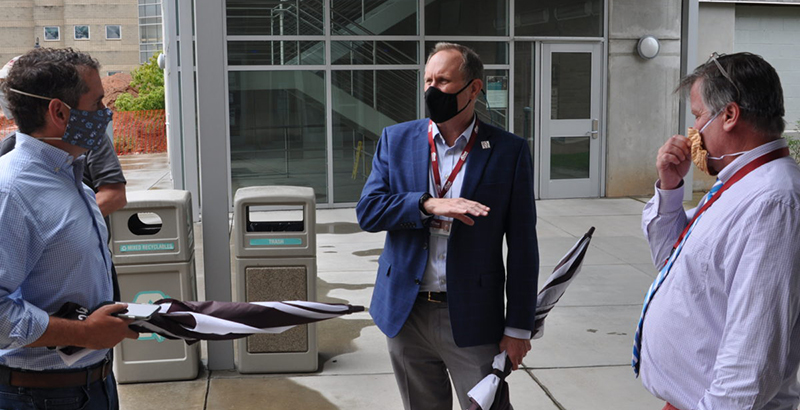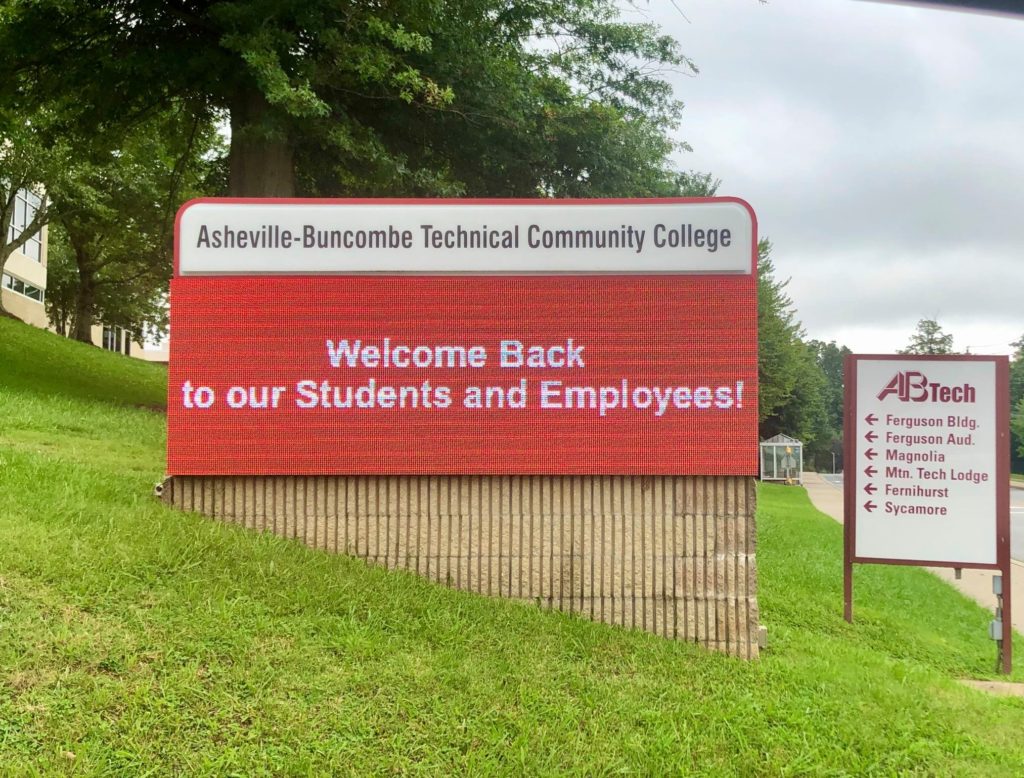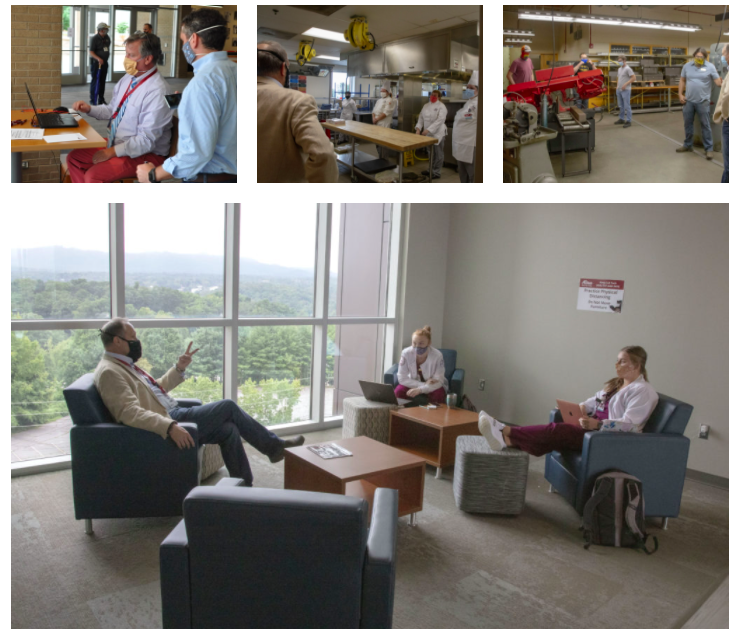Lessons in Leadership From 15 Months of One College Facing Down a Pandemic

Get stories like this delivered straight to your inbox. Sign up for The 74 Newsletter
Gossett, by his nature, is an outgoing leader who projects an aura of optimism and positivity. He grew up right outside of Knoxville, Tennessee, and he takes his fair share of jokes from friends and colleagues arguing that his optimism must come from being a fan of the star-crossed Tennessee Vols football program.
Yet when we caught up in the early days of 2021, I found a leader who was worn down and despairing at the general malaise in the A-B Tech campus community. Gossett wasn’t alone in this — and my conversations with leaders across the state indicated a similar sentiment in those dark days of winter.
As we reflected on those January conversations, Gossett was in a somber mood remembering a winter that was dark for so many.
“In January, of course, the weather’s no good, like all winters are (in the mountains),” he said. “And I don’t know that we saw a light at the end of the tunnel. And as dark as it was, I’m not sure we saw the walls of the tunnel either.”
Mere weeks after the bleakness of January, vaccine shots were going into arms and optimism was rising across the state’s educational landscape. Gossett and his team then turned their attention to planning for a fall semester that would feel closer to normal — or at least a new normal.

When we discussed the rising sense of optimism, Gossett told me, “I don’t think there’s much appetite for going back the way it was in the spring of 2020, where we’re doing everything online. Students were overwhelmingly telling us that they want to be in the classroom with their peers … and we want to be in the classroom. We miss our students.”
Of course, we now know that COVID-19 had more twists and turns ahead for everyone in education — and for all of us.
Over the past 15 months I have spent a significant amount of time with Gossett, A-B Tech’s Executive Leadership team, faculty, staff, and students. I’ve visited campus a half-dozen times, spending more than 20 days in Asheville in all. Gossett and his team provided a unique level of access to conversations, meetings, and the entire A-B Tech community.
Here are some of the lessons I learned during our time together.
Leading a college during a pandemic requires constant adaptation
Beth Stewart serves as the vice president of instructional services for A-B Tech. She shows off her high-energy approach to leadership as she bounces around campus.
When we sat down recently to discuss the constant iteration required of a college during COVID-19, Stewart could only shake her head as she talked about the decision to shut down most in-person instruction: “I have to tell you, (going virtual) was the scariest, most stressful decision I’ve ever had to make as an administrator. And as a whole, I hope this pandemic is a once-in-a-career challenge that we won’t ever have to go through again … I had been on the road prior to everything shutting down. And I was starting to see little indicators of the nervousness of people out in public.”
Stewart said she began to see face masks and hand sanitizers during her travels in late February and early March of 2019 — and when she arrived home, Joe Barwick, the interim president for A-B Tech, asked her what the route forward might be for the college in a pandemic that was quickly arriving. Late on Thursday, March 13, 2020, she wrote faculty and staff to extend spring break by a week to give them more time to convert as much coursework as possible online — a tactic that other community colleges across the state also were using.
Stewart said moving so many courses online was a “monumental task.”
In a piece Stewart wrote for A-B Tech, she said, “On March 13, there were 1,167 sections of classes in session. Only twenty-one percent of those classes were 100 percent online. We faced multiple challenges moving so many classes to a virtual environment including a skills gap for some faculty, inadequate technology to teach remotely, and concerns about Internet access, to name a few. To overcome these challenges, we identified technology resources scattered across campus and reassigned them to faculty. We launched rapid professional development on a variety of topics like Zoom, Moodle, and online best practices. We also offered virtual labs to our faculty where they could get individual help redesigning their classes. We secured virtual labs for science classes and simulators for Allied Health classes.”
And the college continued to adapt after the initial online rollout. Personal training instructors were able to allow their students to conduct PT sessions with clients via Zoom. Zoom also allowed cosmetology students to perform work on mannequins.
This virtual-first environment would be the setting for most courses throughout the 2020-2021 school year — although from the start, in-person exemptions existed for courses such as nursing and emergency medical technicians. The college eventually moved to about 20 percent of classes meeting in-person in the areas of Allied Health, Culinary & Hospitality, Cosmetology, Engineering & Applied Technology, and Emergency Services, Stewart said.
And with vaccination rates increasing throughout the spring and summer, caseloads and hospitalization rates falling, and mask mandates going away, it seemed as if a “new normal” might emerge for the 2021-2022 academic year that would feel a lot closer to life as it was pre-pandemic.
And then along came the Delta variant.
Gossett shook his head as he told me during a conversation in August, “We were planning full steam ahead … and we weren’t worried about masks, we weren’t too worried about social distancing. We were still going to clean and still gonna have hand sanitizers everywhere. But, you know, the last week in July, first week in August, the numbers spiked.”
The day after we spoke, Gossett and his team reinstated the campus mask mandate for the fall semester.

Small gestures can help during an overwhelming time
Gossett wrote a guest essay for us recently where he discussed their embrace of the concept of “grace” from a leadership level on down:
“As we were inundated with news of fear and anger in our society, our leadership team embraced grace for our campus. We worked hard to demonstrate grace with each other, and more importantly, with ourselves. The concept seemed to resonate with our employees and students as we looked for ways to give each other the benefit of the doubt and assume positive intent.”
The concept of grace played out in a number of ways — including Stewart deciding that A-B Tech needed someone to be tasked with monitoring and bolstering morale.
“So in the early days of the pandemic, in the first actual week or so that we were off campus, it became very evident to us that a lot of our faculty and staff were going to struggle with being isolated,” Stewart said. “You know, faculty are usually pretty social beings. They like to talk to their colleagues in the hall, they like to see their students, and all of a sudden to be cut off from all of that was difficult for a lot of our faculty and for our staff.”
Stewart responded by appointing a morale officer, Ron Lane. Lane didn’t add “morale officer” to his official title of dean of academic success, but he was tasked with a key role.
Lane, and the remainder of the team, organized a faculty and staff virtual art show, and a writing showcase, and worked to make their Friday Zoom meetings more personal and creative. Stewart smiled when recounting the numerous pets and grandchildren they met on Zoom — including a pet chicken.
The overall goal of this work? Combat social isolation for folks as the pandemic carried on.
This approach aligned with poker chips Gossett handed out as he would run into folks on campus and in the community. The chips had “Grace” written across them.
Why did they read “Grace”?
“When things get tough, when you’ve had enough for the day, maybe (the chip) can be a reminder to give each other some grace and cut yourself some slack,” Gossett told me. “This pandemic is something that nobody has ever experienced — and we’re all trying to do the best we can with great intentions.”

In addition to the poker chips, Gossett and his leadership team pushed the concept of grace during their meetings as key to their approach with one another, the entire faculty and staff, and the student body.
Do not let a good crisis go to waste
In response to COVID-19, the federal government has distributed an unprecedented amount of money to state and local governments, K-12 districts, and community colleges.
A significant portion of the money came with strings attached — as one might expect given the amount of the investment — including funds that were required to be disbursed directly as student aid, to account for lost revenue, and more. Yet the funds also represented (and continue to represent) a distinct opportunity.
Throughout our conversations, Gossett and Stewart referenced the opportunity presented by COVID-19 as one that would supercharge the college’s move toward the future.
“Most of the changes we’ve implemented since the pandemic hit were going to come to this college, and others, but gradually,” Gossett said. “We’re probably 10 years ahead of where we would have been in some areas.”
Stewart pointed to one such innovation: “The fact that our IT program can now set up virtual servers and students can join on their laptops from anywhere in the world is amazing.”
In the spring of 2020, the college began to buy laptops and mobile hotspots for faculty and staff. When the college first went remote, Stewart related her surprise at how many faculty and staff lacked both a device and internet access at home.
In time, they added remote proctoring services, and virtual tutoring, and began to incorporate trauma-informed teaching into classes as students have faced down the pandemic while trying to learn.
They also bought heavy equipment — including an ambulance.
Stewart and Gossett both noted that while brick and mortar will remain important in higher education, the shift to online learning and virtual environments will provide greater opportunities long-term to students of all types.
“This gives our students better opportunities to be able to take classes … and that’s going to be better for our parents who are students … who maybe can’t take classes during the day,” Stewart said. “They’re gonna be able to take those same classes at night or on the weekends, because they don’t have to have the physical access to the equipment … and that is going to do a lot more for access.”
Gossett echoed the need for A-B Tech, and other colleges, to continue to adapt.
“Our industry is created for the 18- to 21-year-old, with no mortgage, no bills, and no obligations… who can set aside two years, four years, and put everything else on the back burner,” Gossett shared. “That is not reality anymore.”
The common thread from our conversations is A-B Tech leaders’ sincere hope to take the hard-earned lessons of COVID-19 forward with new approaches for the college that will better serve the students of their region.
Stay tuned all week for more content from our time with A-B Tech. We will publish a guest perspective from Gossett and another from a student this week. We will also release a podcast with both Gossett and Stewart sharing the lessons they gained throughout the pandemic.
This article first appeared on EducationNC and is republished here under a Creative Commons license.
Get stories like these delivered straight to your inbox. Sign up for The 74 Newsletter

;)